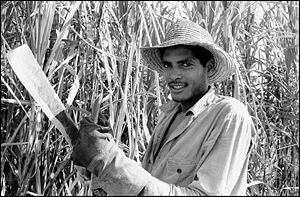.gif)
Zafra (agriculture)
Encyclopedia

Spain
Spain , officially the Kingdom of Spain languages]] under the European Charter for Regional or Minority Languages. In each of these, Spain's official name is as follows:;;;;;;), is a country and member state of the European Union located in southwestern Europe on the Iberian Peninsula...
influence.
In the Caribbean
Caribbean
The Caribbean is a crescent-shaped group of islands more than 2,000 miles long separating the Gulf of Mexico and the Caribbean Sea, to the west and south, from the Atlantic Ocean, to the east and north...
, the term generally refers to the sugar cane harvest (Rojas: 226). There, the zafra runs from January through May (Gorry and Stanley: 141), whereas in the Mediterranean it occurs in September to October. In each case, however, the zafra was closely tied to the life cycle of sugar. Because in the Caribbean cane is ready for harvest at a time of year different than in Spain or North Africa, the meaning of the term has shifted.
The term became well-known internationally during the 1960s due to its importance in Cuba
Cuba
The Republic of Cuba is an island nation in the Caribbean. The nation of Cuba consists of the main island of Cuba, the Isla de la Juventud, and several archipelagos. Havana is the largest city in Cuba and the country's capital. Santiago de Cuba is the second largest city...
. Many leftists visited Cuba during the zafra season to help harvest sugar cane, Cuba's principal crop. The Cuban government for several decades made the La Gran Zafra 'The Great Zafra' a centerpiece of both its economic policy and its international relations campaign. Each year, the government urged everyone to help make the zafra the biggest ever. Schools were often closed, and urban residents frequently relocated to the countryside to assist with the harvest. http://www.historyofcuba.com/history/havana/Sugar2.htm In particular, the goal of reaching the Ten Million Ton Zafra was as much a commonplace of Cuban propaganda as were the apologies and explanations for why the goal was not reached (Pollitt).
Etymology
Linguists agree that the term zafra entered Spanish from Arabic, but there is some disagreement about the precise origins of the term. Some believe it comes fromzāfar or zafariya 'harvest time', while others believe the term derives from saʼifah 'gathering time'. In Spain, the term referred to harvests that took place in September and October and was especially often used to describe the harvest of sugar cane, a crop whose production was brought from Arab lands.

